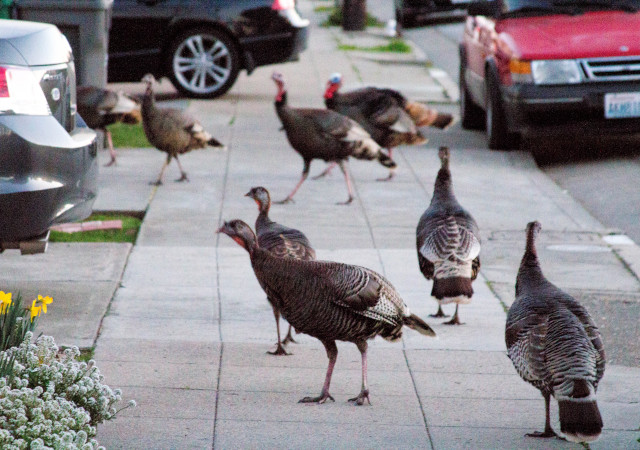
Today, while you're lying on the couch in a tryptophan-induced stupor — though that's a lie! you just ate too much — we bring you a few fun facts about the holiday bird, courtesy University of Illinois Extension. Then we'll review how you think turkey makes you sleepy and why that is not true.
Turkey facts:
- The costume that "Big Bird"wears on Sesame Street is rumored to be made of turkey feathers. [Shocked us, too.]
- Turkeys can see movement almost 100 yards away.
- Turkeys lived almost 10 million years ago.
- Male turkeys gobble. Hens do not. They make a clicking noise.
- Gobbling turkeys can be heard a mile away on a quiet day.
- Turkeys do not really have ears like ours, but they have very good hearing.
- Turkeys can see in color.
- Turkeys do not see well at night.
- In 2012, the average American ate 16 pounds of turkey.
- Turkey consumption has increased 104% since 1970.
- In 1970, 50% of all turkey consumed was during the holidays, now just 29% of all turkey consumed is during the holidays as more turkey is eaten year-round.
- In 2012, turkey was the # 4 protein choice for American consumers behind chicken, beef and pork.
- Turkey has more protein than chicken or beef.
- The average weight of a turkey purchased at Thanksgiving is 15 pounds.
- The heaviest turkey ever raised was 86 pounds, about the size of a large dog.
- The turkey industry employs 20,000 to 25,000 persons in the United States.
- The wild turkey is native to northern Mexico and the eastern United States.
- The turkey was domesticated in Mexico and brought to Europe in the 16th century.
- Turkeys are believed to have been brought to Britain in 1526 by Yorkshire man William Strickland. He acquired six turkeys from American Indian traders and sold them for tuppence in Bristol.
- Henry VIII was the first English King to enjoy turkey and Edward VII made turkey eating fashionable at Christmas.
- 200 years ago in England, turkeys were walked to market in herds. They wore booties to protect their feet. Turkeys were also walked to market in the United States.
- Wild turkeys spend the night in trees. They prefer oak trees.
- Wild turkeys were almost wiped out in the early 1900's. Today there are wild turkeys in every state except Alaska.
- Wild turkeys can fly for short distances up to 55 mph and can run 20 mph.
- Commercially raised turkeys cannot fly.
- A domesticated male turkey can reach a weight of 30 pounds within 18 weeks after hatching.
- Turkey breeding has caused turkey breasts to grow so large that the turkeys fall over.
- Turkeys will have 3,500 feathers at maturity.
- Turkeys have been bred to have white feathers. White feathers have no spots under the skin when plucked.
- Tom turkeys have beards. That is comprised of black, hair-like feathers on their breast.
- The caruncle is a red-pink fleshy growth on the head and upper neck of the turkey.
- Turkeys have a long, red, fleshy growth called the snood from the base of the beak that hangs down over the beak.
- The bright red fleshy growth under a turkey’s throat is called a wattle.
- Turkey eggs hatch in 28 days.
- Turkey eggs are tan with brown specks and are larger than chicken eggs.
- Baby turkeys are called poults and are tan and brown.
- The ballroom dance the "Turkey Trot" was named for the short, jerky steps that turkeys take.
Now, on to the tryptophan lie: You eat a huge turkey meal. You feel like dozing off, and tell all your tablemates. They nod knowingly, murmuring things like "It's the tryptophan," and "Turkey always makes you sleepy."
This, friends, is simply not true, and you should admit to yourself that the reason why you want to lie down and close your eyes is because you just stuffed yourself full of food — not just the protein in turkey, but all those carbs in the bread, potatoes, pie, etc. And you probably drank a bit of wine, too.
Science backs this up. From the New York Daily News:
Tryptophan does play a role in making us drowsy because the body uses it to make both seratonin and melatonin, two happy-sleepy hormones. Like its cousin melatonin, L-tryptophan is marketed as a natural sleep supplement.
The body doesn't make its own tryptophan, so humans must get it from food and turkey is among the many foods that contain it. But turkey contains no more tryptophan than chicken or beef — about 350 mg per 115 g, according to scientists writing in the British Medical Journal (BMJ). Other proteins such as pork, egg whites, soybeans and cod have more tryptophan than turkey. Cheese also has more.
The typical Thanksgiving table is packed with carbohydrates ... and carbs play a role in making tryptophan available to the brain, according to the National Sleep Foundation, which recommends eating a snack of carbs and protein before bedtime for that very reason.